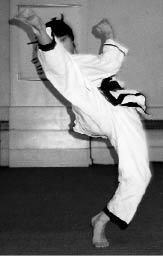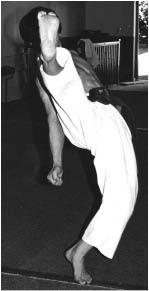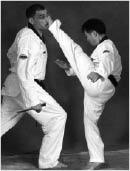Complete Kicking (18 page)
Authors: Turtle Press

purpose
Twist kick is an irregular type of kick which travels in the opposite direction of conventional kicks. The power and effectiveness of twist kick come from coiling and uncoiling the body from an unusual angle, however this also makes it vulnerable. The danger is that you may expose vital targets on your torso after kicking, so you need to protect your body during and after kicking.
key points
Keep your head and standing foot mostly fixed while rotating your chest and hips sequentially in an outward U shape.
striking area
Ball, blade, instep
targets
1. face
2. temple
3. neck
4. rib cage
5. stomach
6. inner thigh
7. inner knee
how to
1. From fighting stance, shift your weight to the front leg.
2. Bring your knee up and twist your body slightly inward, beginning with your chest followed immediately by your hips. As you do so, raise your kicking leg with the foot and knee tilting about 30 to 45 degrees upward.
3. Pivot your standing foot, reverse the rotation of your hip and torso outward, unfold your knee outward, and kick outward-upward with the outside, ball or blade of your foot. All of these steps happen sequentially and almost simultaneously, like coiling and releasing a spring.
variations
Twist kick is useful for kicking soft or vulnerable targets such as the inner thigh, groin, lower abdomen, solar plexus, neck, chin, nose, ears, and mandibular joint. For kicking to the lower abdomen, solar plexus or neck, striking with the ball of the foot (photo 1) is most effective due to its penetrating power. For most of the other targets, the outer side of the foot (photo 2) is effective due to its wide striking surface area.
When striking with the ball of the foot, rotate your body fully so that the ball contacts the target area as sharply as possible.
When striking with the outer side of the foot, put your body weight behind the kick for additional power
applications
This is a kick that is rarely used, so the element of surprise is one of its primary advantages. Use it to shock or confuse your opponent then follow up with a powerful combination such as an elbow strike or roundhouse kick.
SELF-DEFENSE APPLICATIONS
A long twist kick to the groin can stop an advancing assailant.
A good time for a twist kick is after the opponent misses with a forward attack.
hip joint exercises
Because of its unusual path of striking, twist kick can result in injuries to the muscles and joints of the hip or groin. You can improve your flexibility by doing these simple exercises:
Vertical foot lifting: Alternately lift your right and left foot to hip level. Inhale while resting and exhale when you lift your foot. You can do this in-place or while moving around the room, interspersing the knee lifts with footwork. Repeat 3 sets of 20 repetitions, alternating sides.
* After the exercises, shake your legs to release tension in your hips. You can stand and shake one leg at a time or sit on the floor and shake both legs simultaneously.
Outward knee lifting: Lift your knee outward, alternating legs. Raise your foot only to knee level. As you raise your knee and open your hip, your body will twist naturally, creating a coiling motion.
Other books
Deathless Love by Renee Rose
The House Girl by Conklin, Tara
Ian by Elizabeth Rose
A Baby for My Military Stepbrother 3 by Zara, Cassandra
Soulmates Dissipate by Mary B. Morrison
Blood Rebellion (Blood Destiny #7) by Suttle, Connie
MeltWithYou by Lexxie Couper
Loose Ends: A Zombie Novel by Wilburn, Jay
Tamed by Rebecca Zanetti
Project Solaris 2: Hero Rising by Chris Fox









